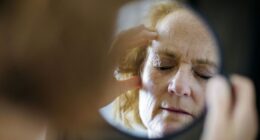
Statins are a group of medicines that are prescribed to people with high levels of “bad” cholesterol known as low-density lipoprotein (LDL). These oral drugs work by reducing the production of LDL cholesterol inside the liver, and are used by about seven to eight million adults in the UK. While statins are considered safe to use, these heart-protecting tablets can trigger several unpleasant side effects, and these are the key symptoms you might experience on your skin.
There are five commonly used statins on offer in the UK which can be split into two key groups.
Low-intensity statins include drugs such as pravastatin, fluvastatin, and simvastatin.
Higher-intensity statins include drugs known as atorvastatin and rosuvastatin.
While all types of statins work to reduce LDL cholesterol, each one can cause different side effects.
According to the medically accredited Mayo Clinic, simvastatin is known to cause a number of changes in the appearance and texture of the skin.
These side effects can resemble common conditions such as eczema and psoriasis, but what exactly should you look for?
READ MORE: Vitamin B12 deficiency: Symptoms in the face
What are the side effects of statins?
NHS advice states that you should always discuss the benefits and risks of taking statins with your doctor before you start taking the medicine.
While some side effects such as headaches, dizziness and nausea are commonly experienced by statin-users, the NHS, along with other medically accredited bodies, has recognised skin conditions as a less common symptom of these cholesterol-blocking drugs.
The Mayo Clinic has identified six skin-based side effects linked to simvastatin, though some are less common than others.
READ RELATED: Covid UK: Daily cases rise a quarter in a week to 90k while hospital admissions and deaths creep up
Flushed, dry skin
Redness and dry flaky skin is a “less common” symptom of simvastatin-use, affecting an estimated 0.1 to one percent of people.
The dry flakiness of the skin can occur when moisture escapes, leaving the surface of your body uncomfortable and dry with a red-flushed hue.
Statins are known to be responsible for this, as they can make the skin more porous which allows a larger quantity of water to escape.
While frequent use of moisturisers and emollients will help to treat the problem short-term, you should consult your doctor if you are concerned about the link between statins and troublesome skin.
Acne
Acne is a common skin condition which affects most people at some point in their life.
Oily skin, spots and painful skin can affect several body parts, though it is most common on the face, back and chest.
Both the NHS and Mayo Clinic recognise acne as “less common” side effect of statin-use.
Overly dry and overly oily skin can both trigger an acne breakout, so it’s no surprise that the drying effects of statins can affect your skin in this way.
Itchy red rash
Uncomfortable skin such as a rash can occur as a result of the drying effects of statins or signal an adverse reaction to the medication.
You should always contact your doctor if you develop a rash while taking statins.
Source: Daily Express










